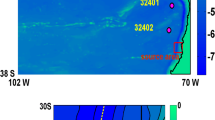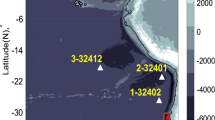Abstract
Application of the \(r-\)solution method to reconstructing the initial tsunami waveform is discussed. This methodology is based on the inversion of remote measurements of water-level data. The wave propagation is considered within the scope of a linear shallow-water theory. The ill-posed inverse problem in question is regularized by means of a least square inversion using the truncated Singular Value Decomposition method. As a result of the numerical process, an r-solution is obtained. The method proposed allows one to control the instability of a numerical solution and to obtain an acceptable result in spite of ill posedness of the problem. Implementation of this methodology to reconstructing of the initial waveform to 2013 Solomon Islands tsunami validates the theoretical conclusion for synthetic data and a model tsunami source: the inversion result strongly depends on data noisiness, the azimuthal and temporal coverage of recording stations with respect to the source area. Furthermore, it is possible to make a preliminary selection of the most informative set of the available recording stations used in the inversion process.





Similar content being viewed by others
References
Baba T. and Cummins Phil R., Contiguous rupture areas of two Nankai Trough earthquakes revealed by high-resolution tsunami waveform inversion, Geophysical Research Letters, VOL. 32, L08305, doi:10.1029/2004GL022320, (2005).
Cheverda,V.A., Kostin,V.I., r-pseudoinverse for compact operator, Siberian Electronic Mathematical Reports, V. 7, 258–282 (2010).
Lavrentiev, M.M, Romanenko,A.A., Lysakov K.F.: Modern Computer Architecture to Speed-Up Calculation of Tsunami Wave Propagation, Proc. of the Eleventh Pacific/Asia Offshore Mech. Symp. Shanghai,China, October 12-16, ISSN 1946-004X, 186–191 (2014).
Percival, D. B., Denbo, D. W., Eble, M. C., Gica, E., Mofjeld, H. O., Spillane, M. C., Tang, L., and Titov, V. V., Extraction of tsunami source coefficients via inversion of DARTr buoy data, Nat. Hazards, V. 58, 567–590 (2011).
Piatanesi, A., Tinti, S., and Pagnoni, G., Tsunami waveform inversion by numerical finite-elements Green’s functions, Nat. Hazards Earth Syst. Sci.,V. 1, 187-194, (2001).
Pires, C. and Miranda, P. M. A., Tsunami waveform inversion by adjoint methods, J. Geophys. Res., V. 106, 19773–19796 (2001).
Satake, K., Inversion of tsunami waveforms for the estimation of a fault heterogeneity: method and numerical experiments, J. Phys. Earth, 35, 241–254 (1987).
Titov, V.V., F.I. Gonzlez, E.N. Bernard, M.C. Eble, H.O. Mofjeld, J.C. Newman, and A.J. Venturato, Real-time tsunami forecasting: Challenges and solutions. Nat. Hazards, 35(1), Special Issue, U.S. National Tsunami Hazard Mitigation Program, 41–58 (2005).
Voronina, T. A. and Tcheverda, V. A., Reconstruction of tsunami initial form via level oscillation, Bull. Nov. Comp. Center, Math. Model. Geoph., V. 4, 127–136 (1998).
Voronina, T. A., Determination of spatial distribution of oscillation sources by remote measurements on a finite set of points, Sib. J. Calc. Math., V. 3, 203–211 (2004).
Voronina, T. A., Reconstruction of Initial Tsunami Waveforms by a Truncated SVD Method, J. Inverse and Ill-posed Problems, V. 19, 615–629 (2012).
Voronina, T. A., Tcheverda, V. A., and Voronin, V. V., Some properties of the inverse operator for a tsunami source recovery, Siberian Electronic Mathematical Reports, V. 11, 532–547 (2014).
Voronin,V.V., Voronina,T.A., and Tcheverda,V.A., Inversion method for initial tsunami waveform reconstruction, Nat. Hazards Earth Syst. Sci., V. 15, 1251–1263 (2015).
Acknowledgments
The authors thank Gorge Shevchenko,Ph.D., from IMGG FEB RAS for his assistance in the preparation of data, David Walsh, Ph.D., and Stuart Weinstein, Ph.D., from NOAA Federal for providing data from DART stations 55012, 55023, 52403,52402, 52406, 51425.
Author information
Authors and Affiliations
Corresponding author
Appendix: Briefly About r-Solution Method
Appendix: Briefly About r-Solution Method
The proposed inversion method was described in detail in previous papers Voronina (2004, 2012), Voronin et al. (2015).
We have proved that the invertible operator \({ {A}}\) described in Sect. 3 of the manuscript acts as \({L_2}(\Omega )\rightarrow {L}_2\left( {\gamma (s)}\times (0,T)\right)\) and it is compact. Therefore, it does not possess a bounded inverse and has a matrix representation. Any compact operator \({ {A}}\) could be described in the Hilbert space by the singular system \(\{s_j,\mathbf {u}_j,\mathbf {v}_j\}\), \(j=1,\ldots \infty\), where \(s_j\ge 0\) (\(s_1\ge s_2 \ge \cdots \ge s_j \ge \cdots\)) are singular values and \(\{\mathbf {u}_j \}\), \(\{\mathbf {v}_j \}\) are the left and the right singular vectors
The compactness of the operator \({ {A}}\) implies the following property: \(s_j\rightarrow 0\) with \(j\rightarrow \infty\). A very important property of the singular vectors is that they form the orthogonal bases in the data and model spaces. Therefore, the solution of Eq. (5) can be given by the expression:
Taking into account the behavior of the singular spectrum of a compact operator from the last formula, one can see that any vanishing perturbation of the right-hand side \(\eta _0(s,t)\) can lead to a significant perturbation of the solution.
The regularization procedure based on truncated Singular Value Decomposition brings about the notion of r-solution given by the relation:
The r-solution is the projection of the exact solution of Eq. (5) onto a linear span of the r right singular vectors corresponding to the top singular values of the compact operator A. This truncated series is stable for any fixed parameter r with respect to perturbations of the right-hand side and the operator itself (Cheverda and Kostin 2010). The value r is determined by the relation
where cond=cond(A) is the users restriction on the conditioning number of the matrix \(\mathbf{A}\). It is obvious that the larger the r, the more informative the solution. Finally, the value of r is determined by the singular spectrum of the matrix \(\mathbf{A}\) which is tightly bounded with the parameters of the observational system.
In a real situation, one can numerically resolve only a finite-dimensional subsystem of the infinite linear system corresponding to Eq. (5) with \(K\times L\) submatrix. As the operator A is compact, its any finite-dimensional approximation by \(K\times L\) matrix will converge to the operator itself for \(K,L\rightarrow \infty\) and, also, the solution of the restricted system \(\varphi (x,y)^{KL}\rightarrow \varphi (x,y)\) (if it exists). The convergence of the r-solution of a finite-dimensional system of linear algebraic equations to the r-solution of an operator equation was investigated in full detail in the study by Cheverda and Kostin (2010).
Let a target domain of the tsunami source be a rectangle \(\Omega = \{(x,y)\in [x_1,x_M]\times [y_1,y_N]\}\). To obtain a system of linear algebraic equations by means of a projective method, a trigonometric basis was chosen in the model space, i.e., an unknown function of the water surface elevation \(\varphi (x,y)\) was approximated by the sum of the spatial harmonics
with unknown coefficients \(\mathbf {c} = \{c_{mn}\}\), and the center of the tsunami source was assumed to be at the point \((x_c,y_c)\), which is the central point of the domain \(\Omega\) as well. Here \(l_1=(x_M-x_1);\ l_2=(y_N-y_1)\). Let us denote
Then we can rewrite (12) in the form
We assumed the synthetic marigrams to be known at the set of points \(\{(x_p,y_p), p=1,\ldots ,P\}\) and for a finite number of time instants \(N_t\). Now, we assume that the dimensions of the solution and the data space are equal to:
Finally, the linear algebraic system for unknown coefficients was obtained:
where \(\mathbf{A}\) is a matrix with columns of computed waveforms at the points \(\{(x_p,y_p), p=1,\ldots ,P\}\) for each spatial harmonic used as a source. The matrix \(\mathbf A\) is a rectangular \((K\times L)\) one, and after the \(\mathbf SVD\) (singular value decomposition) procedure can be written down as \(\mathbf A=\mathbf U\mathbf \Sigma \mathbf {V}^T,\) where \(\ dim(\mathbf{V})=K\times K\) and \(\ dim(\mathbf{U})=L\times L\). The right singular vectors \(\{\mathbf{{v}}_k, k=1,\ldots , K\}\) of the matrix \(\mathbf A\) are columns of the matrix \(\mathbf {V}\), the left singular vectors \(\{\mathbf{{u}}_i,\ i=1,\ldots , L\}\) are columns of the matrix \(\mathbf {U}\). The singular values of the matrix \(\mathbf A\) are sorted in descending order at the main diagonal of the matrix \(\mathbf {\Sigma }\). Then the r -solution of system (14) is represented by the sum
where \(\{\alpha _j = \frac{(\mathbf {\eta _0},\mathbf {u}_j)}{s_j}\}\) and \(\{\mathbf {u}_j\}\), \(\{ \mathbf {v}_j\}\) are the left and the right singular vectors of the matrix \(\mathbf{A}\), \(\{s_j\}\) are its singular values.
Finally, the r-solution of Eq. (14) takes the form:
where \(\{\beta _{mn}^j\}\) are components of the vector \(\mathbf {v}_j\) in the trigonometric basis of the model space. The value r is determined by relation (11). It is clear that the value of r depends on the rate of decreasing the singular spectrum of the matrix A and on the noise level of the observational signals. Indeed, let us assume the perturbation in the right-hand side \(\mathbf{\mathbf {\eta }_0}(s,t)\) be known and can be written in the form
then the perturbed solution will be represented, respectively, as
One should limit the upper index in the last sum depending on the instant when \(s_j\) is far less than \(\varepsilon _j(t)\) to avoid the numerical instability. Note, the obtained number r turns out much smaller than a minimum of the matrix dimensions.
It is clear that the properties of the matrix \(\mathbf A\) and, consequently, the goodness of the recovered function are determined by the location and extent of the tsunamigenic area, configuration of the observational system and the temporal extent and the noise level in the marigrams observed. The analysis of the singular spectrum of the matrix \(\mathbf A\) is the key aspect in the methodology proposed because it allows one to predict a potential result in the recovered function \(\varphi (x,y)\) for a certain observational system and bathymetry.
Rights and permissions
About this article
Cite this article
Voronina, T.A., Romanenko, A.A. The New Method of Tsunami Source Reconstruction With r-Solution Inversion Method. Pure Appl. Geophys. 173, 4089–4099 (2016). https://doi.org/10.1007/s00024-016-1286-z
Received:
Revised:
Accepted:
Published:
Issue Date:
DOI: https://doi.org/10.1007/s00024-016-1286-z




